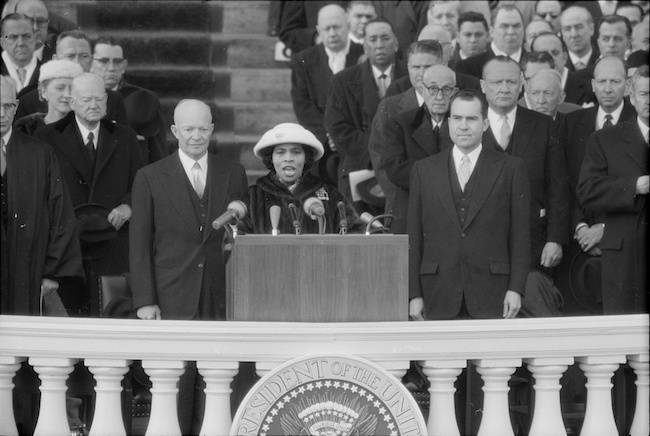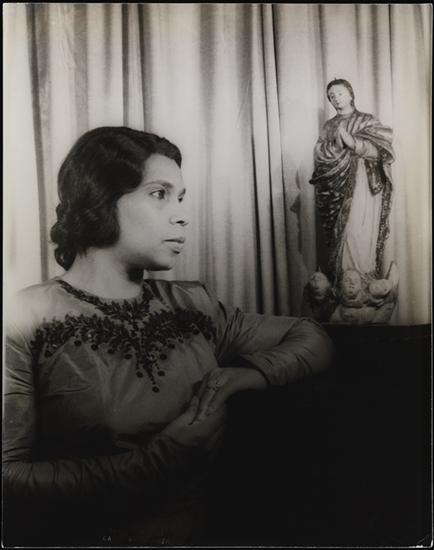Marian Anderson, the Presidential Inauguration Ceremony, and the Order of History
Wednesday, January 27, 2021 by
A week after the 2021 inauguration, it is clear this transition of power has been unlike any other. The violent insurrection of the Capitol building during the presidential vote certification process on January 6, 2021, and an absence of traditional interactions between the departing and incoming president, left little time, understandably, for most Americans to anticipate the inauguration ceremony itself. And yet in the midst of a pandemic that prevented a large-scale in-person celebration, last week's events, from the incredible poetry of Amanda Gorman, to the panoply of accomplished singers—even the subsequent memes—left an impression that prompts us to look back at other significant inaugural moments and performers.
The inauguration has been a ritual since 1789, when George Washington was sworn in as president in New York City. Elements of inaugurations have made history over the years, from the participation of African Americans in the parade following the swearing-in ceremony at Lincoln’s second inauguration in 1865, to Jimmy Carter’s decision to exit his limousine during the parade and walk (soon a presidential tradition unto itself) in 1977. Robert Frost was the first poet to perform, at John F. Kennedy’s inauguration ceremony in 1961, and Marian Anderson was the first African American to perform, when she sang the National Anthem at Eisenhower’s inauguration ceremony outside the Capitol building in 1957.
Anderson’s historic 1957 performance was one of many path-breaking firsts for the acclaimed contralto singer. In 1939, she gave an unprecedented integrated outdoor concert at the Lincoln Memorial attended by 75,000 people, after the Daughters of the American Revolution denied her access to their segregated venue, Constitution Hall. She was the first Black woman to perform with the Metropolitan Opera, in 1955; and the only woman who performed or spoke at the March on Washington for Jobs and Freedom in 1963. She also seems to be the only performer to appear at two inauguration ceremonies, when she sang the National Anthem once again at John F. Kennedy’s swearing-in in 1961.
Exploring Anderson’s career—the Museum of the City of New York has undertaken a project to examine, photograph, and digitize a collection of garments of Anderson’s donated by Bette Midler—underlines how her music sought to bring people together. Facing racism at every stage of her life, Anderson forged her reputation in Europe, returned to the United States to prove herself once again, and spent decades touring the world. She performed a range of music, as intent on singing German lieder as being buttonholed for spirituals. Anderson opposed segregated concerts, but was usually unwilling to cancel them in order to reach more people with her music. She insisted on segregating theaters vertically, however, so Black audiences, too, could be close to the music. She worked with an interracial staff and accompanists, and she created scholarships and inspired generations of future Black singers and performers. Anderson held herself to the highest standards, from the impeccable gowns that she wore to honing the voice that came along only “once in a hundred years.”
It is tempting to view Anderson’s 1957 performance and presence at Eisenhower’s inauguration through that same lens of coming together. She was the first Black inauguration performer, singing in a recently desegregated Washington, D.C. Moreover, Anderson was a friend of former First Lady Eleanor Roosevelt and by all accounts a lifelong Democrat who nevertheless sang at the inauguration of a Republican. Her performance suggests a strike against racial bigotry as well as a more civil, bipartisan era in the nation’s capital.
And yet, Anderson’s performance also belies the notion of bipartisan civility that many are eager to hark back to. While there are few details of Anderson’s 1957 performance, it came after mounting criticism of Eisenhower for the slow pace of desegregation and continuing anti-Black violence. Four Black men began the 1957 term in the House of Representatives, while the Senate—and the vast majority of the federal government—remained all white. Later that year, an angry and organized white mob attacked Black youth attempting to attend high school in Little Rock, Arkansas, requiring the National Guard to quell violence, while viewers around the world watched televised coverage in horror. In the years after Anderson reprised her historic performance at the inauguration of a Democratic president in 1961, the uneasy coalition of New Deal Democrats and Southern Dixiecrats that comprised the Democratic party would irrevocably splinter over racial equality.
The year 2021 follows one of unimaginable loss and grief, enormous and continuous anti-racist mobilizations, and an unprecedented presidential election and transition. It is tempting to feel calmed by the words “this is not who we are.” Yet as other historians have pointed out, the violence in early January in the central seat of the U.S. government has everything to do with racism and white supremacy dating back to the nation’s founding, and perpetuated through the history of slavery, Jim Crow, disfranchisement, and anti-Black violence.
The 2021 inauguration and its attendant hopes and fears evoke breakthrough moments, such as the participation of African Americans in the inaugural parade of 1865 or Anderson’s memorable appearances on the National Mall. It is joyous to listen to Marian Anderson begin with “O Say Can You See” outside the Capitol building and to think of Kamala Harris, the first African American, Asian American, and woman to become Vice President. But it is also imperative to remember the deep rifts that plagued the United States in 1957, as well as the centuries before and decades after, and to remind ourselves that only by confronting those wounds will we strive toward the words Anderson sang, of "the Land of the Free and Home of the Brave."
Stay tuned for more on Marian Anderson as we launch new digital content throughout the month of February, including details on the costume installation, which was led by Callie O'Connor, Costumes and Textiles Collections Assistant, and supported by Julissa Nuñez, Community Collecting Intern.



